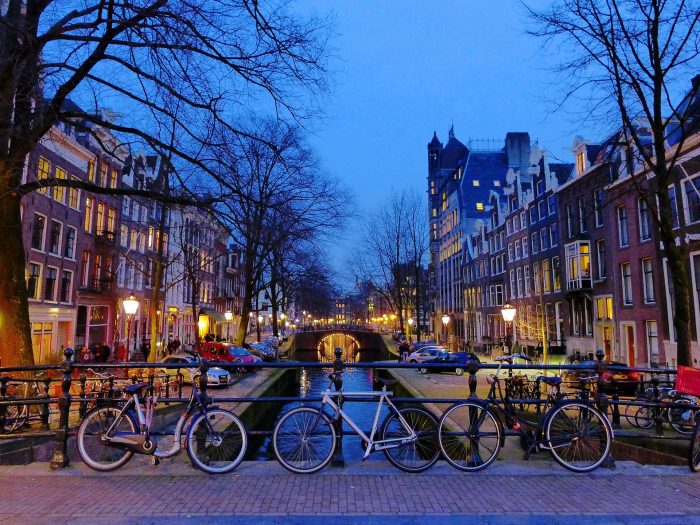The flat landscapes and average temperatures make the Netherlands one of the perfect countries for cycling. Despite its small size, the Netherlands has 35,000km of cycle paths and more than 22.8 million bikes, rather impressive for a country with a population of just 12 million. We are going to discuss the rules and regulations for cycling in Holland including the safety requirements, how to cycle with children, some of the sightseeing paths and some of the riding clubs.
Commuter Cycling
Around 27% of commuter trips are made by bike in the Netherlands, whether it is to work, school or nursery. If you look at a parking lot for employees you will notice just as many bike stalls as there are parking spaces.
With the exception of rush hour, bikes are allowed on trains. It is necessary to buy a bike supplement ticket (Dagkarrt Fiets). You will be able to use this ticket for the whole day. A collapsible bike is can be taken on a train at any time of the day and you will not need to pay an extra charge.
You won’t be able to take a collapsible bike on to a bus or a tram, however it is free to take it on ferries and waterbuses. After 7pm on weekdays and all day on Saturdays and Sundays, you can take a collapsible bike of the RandstadRail network in South Holland.
Cycling As A Hobby
One of the most beautiful ways to see the sights of the Netherlands is by bike. There are copious numbers of cycle routes taking you through fields of tulips and mud, past cheese farms and windmills. You will see historical castles and modern engineering.
When following the routes you can see colour coded signs in green and white. The routes are lined with posts and maps. The maps indicate where you are and the next destinations. Parts of the route are all numbered.
If you need assistance planning your own route you can use the LF route planner.
Cycling Organisations In The Netherlands
Stichting Landelijk Fietsplatform – The national cycling association in the Netherlands. They have control over 4,500km of cycle paths and their main use is for sightseeing and hobbies.
The KNWU – The Royal Dutch Cycling Federation. Focusing on cycling sports such as road, track, field, beach and mountain biking. Other sports include para-cycling and art-wheel riding.
Fietersbond – The Dutch Cycling Association. Campaigning for increased safety across the Netherlands.
The Dutch Cycling Embassy- Knowledge behind cycling. They provide statistics to government, businesses and cyclists.
The ANWB- Dutch automobile and touring club. It has a chain of stores throughout the Netherlands, selling maps, clothes and accessories for bikes. You can also get your bike checked, roadside assistance, insurance and biking holidays.
The Rules For Cyclists In Holland
Safety is absolutely critical in Holland and there are laws strictly enforced by local police. Below are the laws, which must be followed unless you want to get a fine.
- Traffic signals:
You have to stop at a red light. If an intersection has two green lights, follow the green light designated for vehicles, not pedestrians. If there are three green lights, follow the green light with a bike. Pedestrian lights normally turn green first, then bikes, then vehicles. If a light is red, a cyclist may go ahead and turn right if they have checked for all other oncoming traffic.
- Cycling on sidewalks/pavements:
This is not permitted, nor is cycling through pedestrian areas.
- Bike lanes:
You must cycle on bike lanes or paths, indicated by blue circles. Optional bike paths are indicated by a square blue sign and ‘Fietspad’.
- Cycling in parks
You are not permitted to cycle on pedestrian paths in parks, forests, woods or areas of recreation.
- Cycling abreast:
You may only cycle two abreast if there is enough space for a faster cyclist to overtake. If not, the cyclist on the left must fall back.
- Bicycle lights:
On the front of your bike there must be one solid white light pointing forward. On the rear, one solid red light.
- Changing direction:
You must extend the right arm to turn right and extend the left arm to turn left.
- Transporting children:
If the child is under the age of 8, they must be secured in a seat that is adequate for their weight.
- The use of mobiles:
As of the 1st of July 2019, you are not allowed to use a hand held mobile while cycling.
- Alcohol:
If your blood alcohol level is more than 0.5% you cannot ride a bike, nor can you cycle while under the influence of drugs.
- Electric bikes:
If you have an electric bike, you must comply with the same rules as a standard bike, so a maximum of 25kph. Speed pedelec e-bikes have different rules as they come under the category of a moped.
It is not actually Dutch Law to wear a cycle helmet, that being said, it is still highly recommended.



